No results were found for the filter!
SAMPLE PACK
 MOP Sample Pack (phospho- and...
MOP Sample Pack (phospho- and... MOP Sample Pack consisting of all four available phospho- and one non-phospho-µ-Opioid Receptor Antibodies 5 x 20 µL trial size each. Specifically, this sample pack contains the following antibodies pT370-MOP (7TM0319B), pS375-MOP...
$ 300.00 *
Citations
KO-Validated
 MOP (GP-IHC-grade), µ-Opioid Receptor Antibody,...
MOP (GP-IHC-grade), µ-Opioid Receptor Antibody,... The µ-Opioid Receptor antibody is directed against the distal end of the carboxyl-terminal tail of mouse, rat and human MOP. It detects selectively the canonical form of MOP and none of the putative splice variants. In can be used to...
$ 375.00 *
Citations
KO-Validated
 MOP (GP-non-phospho), µ-Opioid Receptor...
MOP (GP-non-phospho), µ-Opioid Receptor... The non-phospho-µ-opioid receptor antibody is directed against the distal end of the carboxyl-terminal tail of mouse, rat and human MOP. It detects selectively the canonical form of MOP and none of the putative splice variants. It can be...
$ 375.00 *
Citations
KO-Validated
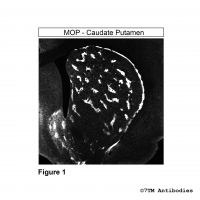 MOP (IHC-grade), µ-Opioid Receptor Antibody
MOP (IHC-grade), µ-Opioid Receptor Antibody The µ-Opioid Receptor antibody is directed against the distal end of the carboxyl-terminal tail of mouse, rat and human MOP. It detects selectively the canonical form of MOP and none of the putative splice variants. In can be used to...
$ 375.00 *
Citations
NEW
KO-Validated
 pS375-MOP (IHC-grade phospho-µ-Opioid Receptor...
pS375-MOP (IHC-grade phospho-µ-Opioid Receptor... Serine375 (S375) is the primary phosphorylation site in a hierarchical phosphorylation cascade. The pS375-MOP antibody detects phosphorylation in response to high- and low-efficacy agonists but not after PKC activation. S375...
$ 500.00 *
Citations
NEW
KO-Validated
 pT376-MOP (IHC-grade phospho-µ-Opioid Receptor...
pT376-MOP (IHC-grade phospho-µ-Opioid Receptor... Threonine376 (T376) is a major phosphorylation site of the µ-opioid receptor (MOP). The pT376-MOP antibody detects phosphorylation in response to high-efficacy agonists but to low-efficacy agonists or after PKC activation. T376...
$ 500.00 *
Citations
NEW
KO-Validated
 pT379-MOP (IHC-grade phospho-µ-Opioid Receptor...
pT379-MOP (IHC-grade phospho-µ-Opioid Receptor... Threonine379 (T379) is a major phosphorylation site of the µ-opioid receptor (MOP). The pT379-MOP antibody detects phosphorylation in response to high-efficacy agonists but to low-efficacy agonists or after PKC activation. T379...
$ 500.00 *
Citations
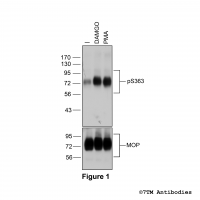 pS363-MOP (phospho-µ-Opioid Receptor Antibody)
pS363-MOP (phospho-µ-Opioid Receptor Antibody) Serine363 (S363) is a constitutive phosphorylation site of the µ-opioid receptor (MOP). The pT363-MOP antibody detects phosphorylated MOP in cultured cells. S363 is a substrate for PKC-mediated phosphorylation.
$ 375.00 *
Citations
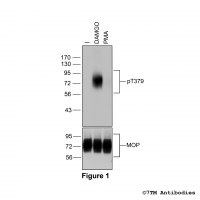 pT379-MOP (phospho-µ-Opioid Receptor Antibody)
pT379-MOP (phospho-µ-Opioid Receptor Antibody) Threonine379 (T379) is a major phosphorylation site of the µ-opioid receptor (MOP). The pT379-MOP antibody detects phosphorylation in response to high-efficacy agonists but to low-efficacy agonists or after PKC activation. T379...
$ 375.00 *
Citations
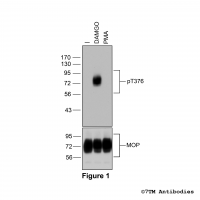 pT376-MOP (phospho-µ-Opioid Receptor Antibody)
pT376-MOP (phospho-µ-Opioid Receptor Antibody) Threonine376 (T376) is a major phosphorylation site of the µ-opioid receptor (MOP). The pT376-MOP antibody detects phosphorylation in response to high-efficacy agonists but to low-efficacy agonists or after PKC activation. T376...
$ 375.00 *
Citations
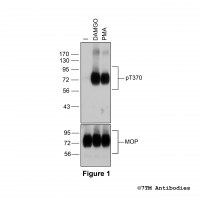 pT370-MOP (phospho-µ-Opioid Receptor Antibody)
pT370-MOP (phospho-µ-Opioid Receptor Antibody) Threonine370 (T370) is a major phosphorylation site of the µ-opioid receptor (MOP). The pT370-MOP antibody detects phosphorylation in response to high-efficacy agonists but to low-efficacy agonists. The pT370-MOP antibody also detects...
$ 375.00 *
Citations
KO-Validated
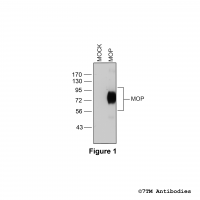 MOP (non-phospho), µ-Opioid Receptor Antibody
MOP (non-phospho), µ-Opioid Receptor Antibody The non-phospho-µ-opioid receptor antibody is directed against the distal end of the carboxyl-terminal tail of mouse, rat and human MOP. It detects selectively the canonical form of MOP and none of the putative splice variants. It can be...
$ 375.00 *
Citations
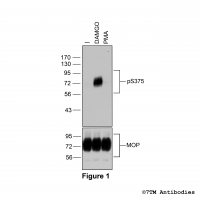 pS375-MOP (phospho-µ-Opioid Receptor Antibody)
pS375-MOP (phospho-µ-Opioid Receptor Antibody) Serine375 (S375) is the primary phosphorylation site in a hierarchical phosphorylation cascade. The pS375-MOP antibody detects phosphorylation in response to high- and low-efficacy agonists but not after PKC activation. S375...
$ 375.00 *
Recently viewed


